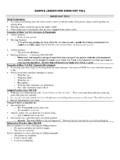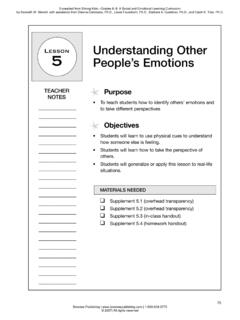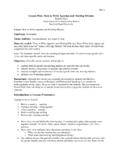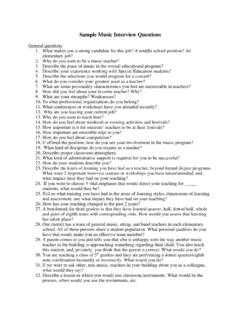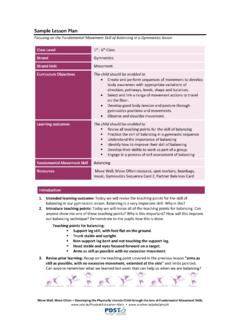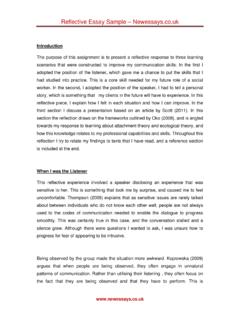Transcription of Tier 2 Intervention Toolbox - pbis.serc.co
1 tier 2: Intervention Toolbox Response to Intervention : Behavior Collaborative Strategies Behavior Education Program - Check In/Check out (CICO) (See Collaborative Strategies Appendix at the end of this guide for a more detailed description) What is it? CICO, also known as Behavior Education Program (BEP), is a beginning of the day check in and end of the day check out. The focus of the BEP is on academic and social compliance. It is used to help teach and reinforce academic and social skills a student needs to be successful in the classroom. It is important that all staff members prompt and reinforce the student to use the identified skills. What it looks like: The BEP form is given to the teacher prior to each period. At the end of the day the points are tallied and are aligned with a reward or motivating reinforcement.
2 The form is taken home and signed by the parent and returned to school the next morning. In order to participate in the program a student may take part in reading and signing a Check and Connect contract. Others that may sign this contract are the student s parents, the teacher, and the program coordinator. Resources: Check and Connect What is it? A model to promote students' engagement with school, reduce dropout, and increase school completion. The Check & Connect model originated from a partnership of researchers, practitioners, parents, and students led by the Institute on Community Integration, University of Minnesota. Check & Connect is a model of sustained Intervention for promoting students' engagement with school and learning. Demonstrated outcomes include: decrease in truancy, decrease in dropout rates, increase in accrual of credits, increase in school completion, and impact on literacy.
3 Check & Connect is data-driven and grounded in research on resiliency and home-school collaboration. Student referral criteria include alterable warning signs of school withdrawal primarily attendance indices (absences, tardies, or skipping class) in the context of academic performance and emotional or behavioral problems. What it looks like: Check & Connect is implemented by a person referred to as a monitor or mentor. The person is a cross between a mentor, an advocate, and a service coordinator whose primary goal is to keep education a salient issue for disengaged students and their teachers and family members. The monitor/mentor works with a caseload of students and families over time (at least two years) and follows their caseload from program to program and school to school. Check & Connect is structured to maximize personal contact and opportunities to build trusting relationships.
4 Student levels of engagement (such as attendance, grades, and suspensions) are "checked" regularly and used to guide the monitors' efforts to increase and maintain students' "connection" with school Resources: Behavior Contracting What is it? A behavior contract is an agreement between the child and teacher and often includes the student's parent/guardian(s). The behavior contract is a written agreement about how the individual will behave. It will indicate the appropriate consequence should the student neglect to behave according to the contract and it also identifies a reinforcer to be used for successful compliance. The behavior contract provides the student with structure and self-management. The behavior contract is often an effective form of behavior modification. What it looks like: The contract should be written with the student and teacher - collaboration.
5 It would be wise to involve the parent under certain circumstances. The contract should include the following: The goal. (Will only speak when called on, will keep hands to self, will turn in 90% of homework assignments, etc.) How will the student receive the reward? (Become the teacher's monitor after completing 5 assignments on time etc.) What is the consequence should the child not adhere to the behavior described in the contract? Time should be clearly stated in the contract. You may choose a half day, a full day, a week etc. Define who and how the behavior will be monitored. (teacher initials, stickers, check mark system etc.) Set a date for reviewing the contract Resources: Cooperative Discipline What is it? Cooperative Discipline is a theory of discipline that seems to work for children of today; it offers corrective, supportive, and most important preventive strategies.
6 Cooperative Discipline promotes cooperative relationships among the main participants: students, teachers, administrators, and parents (or guardians). What it looks like: Cooperative Discipline uses three sets of strategies to encourage students to behave appropriately and choose responsible behavior. Students need to feel capable, connected, and able to contribute in class. Students need to fell capable of succeeding academically as well as socially. To have a student feel capable, teachers need to allow students to know it is okay to make mistakes. By making learning objectives attainable for all students, children will feel successful and confident. Resources Peer Tutoring What is it? Class-wide peer tutoring is a way for all student s to get one-on-one help and enough time to practice and learn. Peer tutoring can also be organized to be a school-wide initiative to help facilitate both academic and behavior gains through and among classrooms and grade levels.
7 The program can be organized as an after school program or during the academic day. What it looks like: For Class-wide Peer Tutoring, every student in the class is paired with another. The teacher writes lessons that one student uses to teach or tutor another. During the tutoring, one student explains the work to another student, asks the student to answer questions, and tells the student whether his or her answers are correct. Resources Center for Effective Collaboration and Practice, Council for Exceptional Children, Small Group Strategies Time Management Training What is it? Teaching students to make good use of the hours and minutes of the day by planning, prioritizing, and sticking to a schedule. What it looks like: Activity Examples: Practice time estimation. Make a game out of predicting, timing, and checking students' estimates of the time needed for various activities.
8 How long does it take to walk from the classroom to the school office? Use an analog clock. Digital clocks are easier to read, but an old-fashioned clock with hands gives students a better sense of how swiftly time passes. Set a timer to motivate targeted behaviors. To help with transitions, for example, tell students they have five minutes to finish their work, and set an alarm to signal when time is up. Make sure students begin tasks promptly. Children with time management struggles often use delaying tactics like sharpening a pencil to put off doing tasks they find boring. Stand next to your dawdlers to get them started. If punctuality is a problem, include it as a goal on a daily report card or as part of a behavioral contract A written class schedule provides structure for the school day and breaks time into meaningful chunks. Review it each morning, and refer to it throughout the day, noting the time allotted for each activity.
9 Attach a daily to-do list to each desk, and see that your students get in the habit of crossing off accomplished tasks. Have them add personal reminders like "bring lunch money to office" or "return library books" and work together on prioritization. Resources: Social Skills Group What is it? A social skill is any skill facilitating interaction and communication with others. Social rules and relations are created, communicated, and changed in verbal and nonverbal ways. The process of learning such skills is called socialization. What it looks like: Social skills are best taught in the environment in which they are to be demonstrated, in the case of schools, in the classroom. They are best taught in the entire school consistently. They can, however, be taught in smaller groups such as by a Guidance Counselor. Social skills such as empathy and listening can be taught like academic subjects such as math and reading.
10 Teaching involves allowing students to model and role play the correct behavior in social situations. Posters involving the skills and the steps involved in demonstrating them should be displayed in the room to cue the students. Empathy should be taught initially since it is basic to most of the other skills. Clear and specific activities for all staff to follow must be provided to promote generalization and make sure that staff uses strategies. ( tell , SHOW, AND PRACTICE!) When to use it: Teach social skills in naturally occurring settings. Use naturally occurring reinforcers. Use language of school-wide positive behavior system Pinpoint activities student likely to engage Use Generalization strategies to help apply skills to all settings Resources: Learning for Life Curriculum, Prepare Curriculum (Secondary Level) Second Step Social Skills Curriculum, Conflict Resolution Training What is it?
